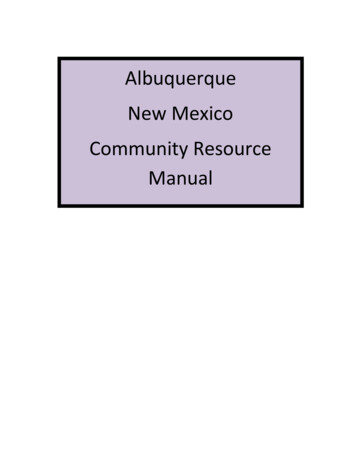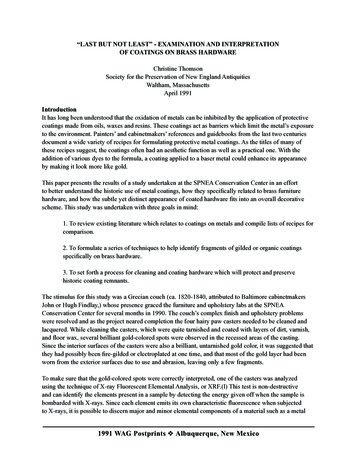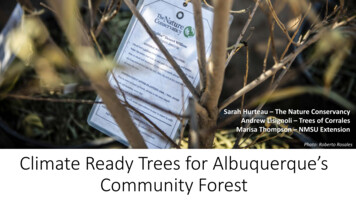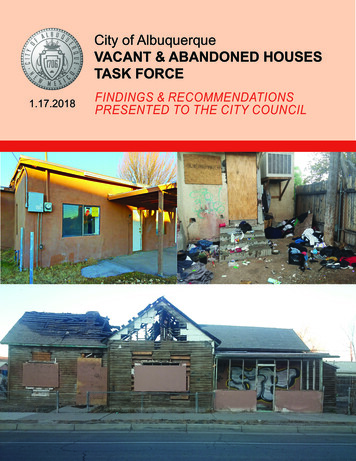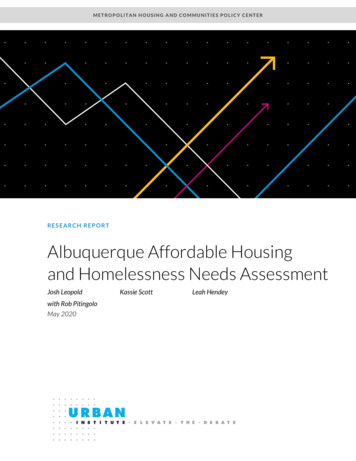
Transcription
AlbuquerqueLa Niña’s Stifling Dry In Spring Can Change Rapidly in JunePolar Jet StreamWEATHER FORECAST OFFICE**Updated 6/5/2022 to include more weekly ECWMF precipitationand temperature forecasts for late June thru mid July 2022**Columbia Climate School – International Research Institute (IRI)Why has it been so extraordinarily dry this spring? The above image (left) shows outgoing longwave radiation (OLR) differencefrom average from Feb-Apr 2022. What does it show? The cooler than average waters in the central and eastern Pacific Ocean(EPAC) that define La Niña lead to above average thunderstorm activity in the west Pacific and Maritime Continent (dark greenshading). The air associated with these storms rises and is forced to sink to the east (top right image), essentially wiping outthunderstorm potential in the EPAC. It’s the lack of these thunderstorms that result in a storm track that remains north of NewMexico during spring. Additionally, the circulation that La Niña creates also negates the effects of the Madden-Julian Oscillation(MJO) as it travels eastward through the eastern Pacific. The MJO in fall and spring often leads to key shifts in the storm track.
AlbuquerqueLa Niña’s Stifling Dry In Spring Can Change Rapidly in JuneWEATHER FORECAST OFFICEU.S. Drought Monitor showing that much of New Mexico remains in Extreme to Exceptional Drought. New Mexico and much ofthe western half of the country are in a two decade-long plus megadrought. It’s considered the most extreme drought in at leastthe past 1,200 years. By examining tree ring data from Montana to northern Mexico and from the Pacific Ocean to the RockyMountains, climate scientists concluded that this is no ordinary drought. Soil moisture deficits doubled since 2000 whencompared with levels in the1900s. The study also found that anthropogenic warming contributed to a 42% increase in droughtseverity.
AlbuquerqueLa Niña’s Stifling Dry In Spring Can Change Rapidly in JuneWEATHER FORECAST OFFICE Multivariate ENSO Index(MEI) for MAR-APR 2022:-1.6 Pacific Decadal Oscillation(PDO) for APR 2022: -1.51 Atlantic MultidecadalOscillation (AMO) for APR 2022: 0.116 Oceanic Niño Index (ONI)(uses Niño 3.4 region - innerrectangle) for FMA 2022: -1.0Latest weekly global SST anomalies showing the area of cooler than average temperatures in the eastern EquatorialPacific continue to show La Niña hanging on.
AlbuquerqueLa Niña’s Stifling Dry In Spring Can Change Rapidly in JuneWEATHER FORECAST OFFICENegative subsurface temperature anomalies prevailed near the surface across most of the equatorial Pacific Ocean in spring.Could a “triple-dip” La Niña be in the cards in fall? It’s looking more likely with each model run (slide 15).
AlbuquerqueLa Niña’s Stifling Dry In Spring Can Change Rapidly in JuneTypical JetStream Patternduring La NiñaWEATHER FORECAST OFFICETypical JetStream Patternduring El NiñoTypical Tropicalcirculationsduring El NiñoTypical Tropicalcirculationsduring La NiñaWarmer SSTs support deep tropical and subtropical convection farther east than average. This deep convection draws the jet stream farthersouth into the far eastern Pacific Ocean and southwestern United States during El Niño. The opposite is true during moderate to strong LaNiñas and the polar jet stream generally remains north of New Mexico. Weak La Niñas are sometimes wetter and cooler than average.
AlbuquerqueLa Niña’s Stifling Dry In Spring Can Change Rapidly in JuneWEATHER FORECAST OFFICEPacific North AmericanPattern (PNA)Air pressure in the lower atmosphere compared to the 1981-2010 average during February 2016 (top), when the PNA waspositive, and in February 2019 (bottom), when it was negative. The location of highs and lows and the flow of the jet streamaround them often produce a sharp warm-cold split in temperatures in the western and eastern halves of the United States. ForNew Mexico, often times a negative phase of the PNA leads to upper-level low pressure systems digging southward through theGreat Basin, often times accompanied by strong backdoor cold fronts. The long-lived negative PNA this spring has ledextraordinarily dry weather for NM and much of the Southwest U.S.
AlbuquerqueLa Niña’s Stifling Dry In Spring Can Change Rapidly in JuneStronger than average polarjet stream in JJA 2021WEATHER FORECAST OFFICEStronger than average polarjet helped draw the FourCorners or monsoon highnorthwestwardDifference from average zonal (west to east) wind at 250mb or 43,000 feet MSL along with 500mb or 18,000 feet MSLshowing a stronger (7m/s 16 mph) than average jet stream across much of Canada. Could 2021 be an analog year? Mostdefinitely. Why? Not much has changed since last summer in the tropics and subtropics over the past year. An above averagepolar jet remains over Canada and is forecast to continue a through summer. The stronger than average polar jet stream orstorm track helped draw the Four Corners’ High well northwest of NM last summer, allowing more backdoor fronts to bringGulf of Mexico moisture into NM from the east and northeast. Expect a similar weather pattern set-up in 2022, but not thesame.
AlbuquerqueLa Niña’s Stifling Dry In Spring Can Change Rapidly in JuneWEATHER FORECAST OFFICEWhat happened last year? A robust late June and July that waned in August and September. While two monsoon seasons arenever the same, this year’s set-up looks similar to last year.
AlbuquerqueLa Niña’s Stifling Dry In Spring Can Change Rapidly in JuneWEATHER FORECAST OFFICEMean Precipitation Forecasts Difference from AverageA very recent study (March 2022) from scientists at the National Center for Atmospheric Research (NCAR) in Boulder, CO,Bureau of Reclamation (Upper Colorado Region, Albuquerque, NM), and the Bureau of Reclamation (Lower Colorado Region,Boulder, NV) concluded that the European Centre for Medium Range Weather Forecasts (ECMWF) Integrated Forecast System(IFS) model was able to skillfully predict the monsoon. Its superior simulation of the location and seasonal evolution of the FourCorners’ High (FCH) or monsoonal high pressure ridge/dome “outperforms the other models in simulating teleconnectionpatterns that control the position of the monsoon high and the amount of regional precipitation” (Prein et al. 2022).
AlbuquerqueLa Niña’s Stifling Dry In Spring Can Change Rapidly in JuneWEATHER FORECAST OFFICEProbability of Precipitation Exceeding MedianSeasonal forecasts from the ECMWF showing the probability of precipitation exceeding a median (middle value vs. average)precipitation value. Median values calculated using a1993-2016 climatology. The most likely time for convective rainfall to exceedthe median appears in late June through July.
AlbuquerqueLa Niña’s Stifling Dry In Spring Can Change Rapidly in JuneWEATHER FORECAST OFFICEECMWF weekly precipitation difference from average forecast, essentially showing the onset of this year’s monsoon during theweek of June 20, 2022.
AlbuquerqueLa Niña’s Stifling Dry In Spring Can Change Rapidly in JuneWEATHER FORECAST OFFICEECMWF weekly precipitation difference from average forecasts for early to mid July 2022. The week of July 4 is forecast by theEuropean model to be active for northern and western NM.
AlbuquerqueLa Niña’s Stifling Dry In Spring Can Change Rapidly in JuneWEATHER FORECAST OFFICEECMWF weekly temperature forecasts difference from average for late June into early July showing near average temperaturesforecast for much of the Land of Enchantment.
AlbuquerqueLa Niña’s Stifling Dry In Spring Can Change Rapidly in JuneWEATHER FORECAST OFFICEECMWF weekly temperature forecasts difference from average for early to mid July showing near averagetemperatures are forecast for much of NM.
AlbuquerqueLa Niña’s Stifling Dry In Spring Can Change Rapidly in JuneWEATHER FORECAST OFFICEJune-August 2022 model precipitation rate anomaly from the two climate models that have the highest forecast skill percentagesfor NM (top), the North American Multi-Model Ensemble (NMME) and the Geophysical Fluid Dynamics Laboratory(GFDL SPEAR) model. Both model forecasts are predicting slightly below average precipitation for JJA 2022.
AlbuquerqueLa Niña’s Stifling Dry In Spring Can Change Rapidly in JuneWEATHER FORECAST OFFICEWhat if the month of June is singled out? Not much changes but average (white) precipitation over much of AZ is encouraging.It’s worth reiterating that this year looks similar to last year when climate models were forecasting a very similar summerpattern.
AlbuquerqueLa Niña’s Stifling Dry In Spring Can Change Rapidly in JuneWEATHER FORECAST OFFICEModel temperature anomaly forecasts from the two climate models that have the highest forecast skill percentages (top row),the North American Multi-Model Ensemble (NMME) and the GFDL SPEAR model. Both model forecasts are predicting slightlyabove to above average temperatures for JJA 2022.
AlbuquerqueLa Niña’s Stifling Dry In Spring Can Change Rapidly in JuneWEATHER FORECAST OFFICEClimate Prediction Center’s Official 2022 Climate Outlook for June, July and August showing probabilities favoringabove average temperatures and near to slightly below average precipitation.
AlbuquerqueLa Niña’s Stifling Dry In Spring Can Change Rapidly in JuneWEATHER FORECAST OFFICEThe vast majority of climate model forecasts keep SSTAs in the eastern equatorial Pacific in La Niña territory (0.5 C or below ) during the northern hemisphere summer, transitioning to neutral conditions by late fall or earlywinter. Is a triple-dip in the cards next fall? Triple dips are a rare occurrence. There have only been 2 “triple-dip” LaNiña events since 1950 so probabilities are fairly low but increasing.
AlbuquerqueLa Niña’s Stifling Dry In Spring Can Change Rapidly in JuneWEATHER FORECAST OFFICEBurn Scars Lead to an Increased Risk of Flash Flooding and Debris FlowsCourtesy: BAERCourtesy: Paul JaramilloThe exceptional wildfire season of 2022 will have long lasting effects on the slopes of the southeastern Sangre de Cristo and westslopes of the Black Range in southeast Catron County, both in the immediate area and for locations several miles away. Areasdownhill and downstream from burned areas are tremendously vulnerable to Flash Flooding and Debris Flows, especiallynear steep slopes. Rainfall that would normally be absorbed by soil and vegetation will run off quickly after a wildfire, as burnedsoil can be as water repellant as pavement. As a result, much less rainfall is required to produce a flash flood over a burn scar. Agood rule of thumb is: "If you can look uphill from where you are and see a burned out area, you are at risk."
AlbuquerqueLa Niña’s Stifling Dry In Spring Can Change Rapidly in JuneWEATHER FORECAST OFFICE Forecasts from the ECMWF extended and long-range forecast model along with avery recent analog year (2021) indicate that precipitation in central and northernNew Mexico during JJA will range from slightly below to near climatological averages.Forecasts from the ECMWF and other climate models along with one very recentanalog year suggest temperatures during JJA will be slightly above to above average.
AlbuquerqueLa Niña’s Stifling Dry In Spring Can Change Rapidly in JuneWEATHER FORECAST OFFICE Prein, A.F., Towler, E., Ge, M., Llewellyn, D., Baker, S., Tighi, S., & Barrett, L. (2022).Sub-seasonal predictability of North American Monsoon precipitation. GeophysicalResearch Letters, 49, e2021GL095602. Outlook provided by National Weather Service Forecast Office Albuquerque, NM. For further information contact Andrew Church: andrew.church@noaa.gov (505) 2449150
Albuquerque La Niña's Stifling Dry In Spring Can Change Rapidly in June WEATHER FORECAST OFFICE U.S. Drought Monitor showing that much of New Mexico remains in Extreme to Exceptional Drought. New Mexico and much of the western half of the country are in a two decade-long plus megadrought. It'sconsidered the most extreme drought in at least
